Disclosure: This post may contain affiliate links. I may earn a small commission for my endorsement, recommendation, testimonial, and/or link to any products or services from this website.
Learn how to make the best Vegan Takeout-Style Fried Rice at home, in only 20 minutes! This Fried Rice is perfectly seasoned, fluffy, and golden.
Fried Rice — what’s not to love? There’s a reason that this dish of toasty, golden bits of fluffy rice tossed with well-seasoned veggies is a popular staple on almost all takeout menus. Today we’re tackling The BEST Vegan Takeout-Style Fried Rice…seriously. Thanks to a few tried-and-true tips and tricks, you can make your favorite fried rice from the comfort of your home, all in about 20 minutes.
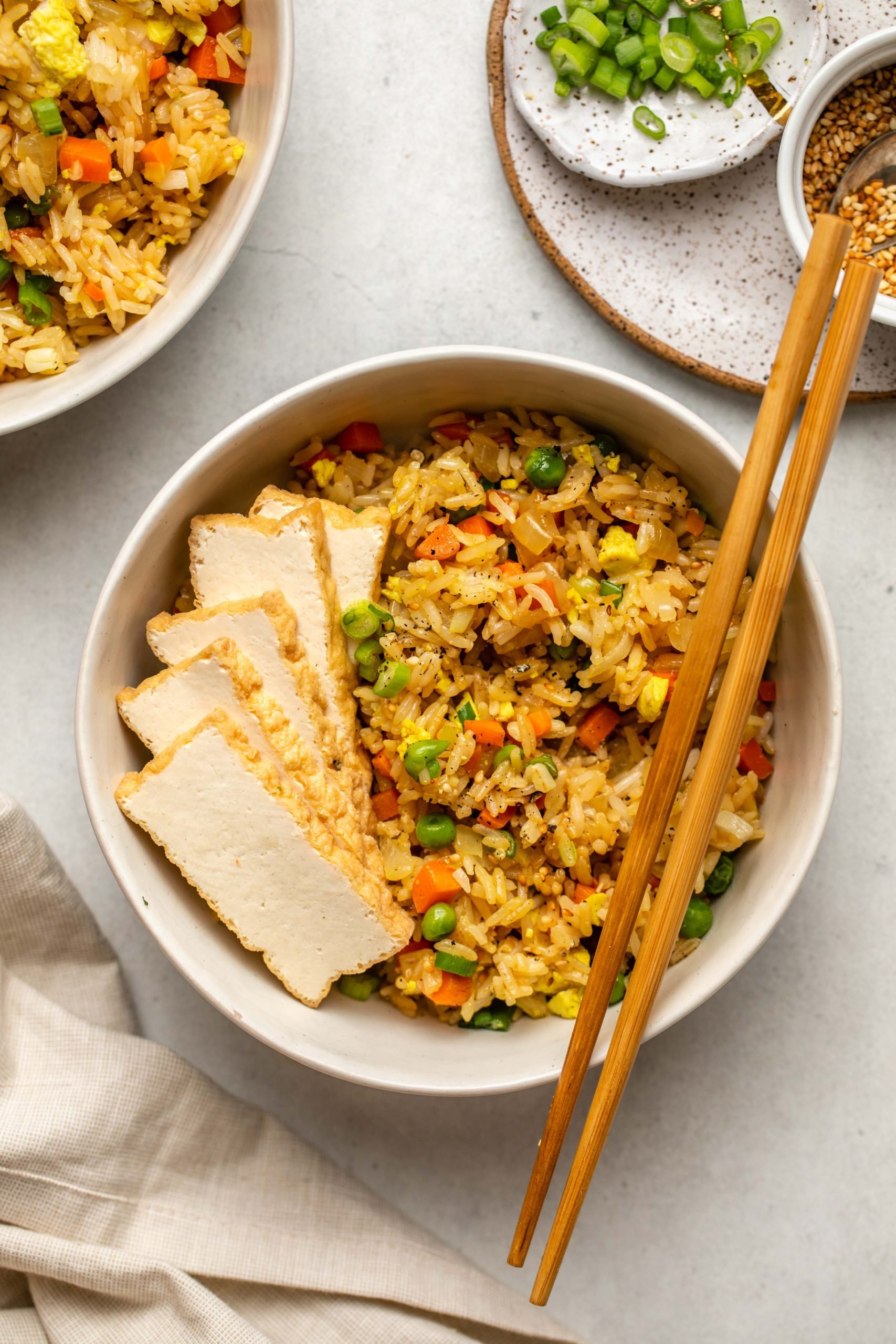
INSPIRATION + INGREDIENTS
Fried Rice has been a staple in Asian cuisine for centuries, and dates all the way back to the Sui Dynasty (589–618 CE) in China. In its most simple form, fried rice consists of rice, oil, and heat; it was simply a common way of reheating leftover rice from the night before. That being said, there are many variations of the dish that are popular today – this recipe is meant to imitate Chinese-American “fusion” Fried Rice, which consists of the following ingredients:
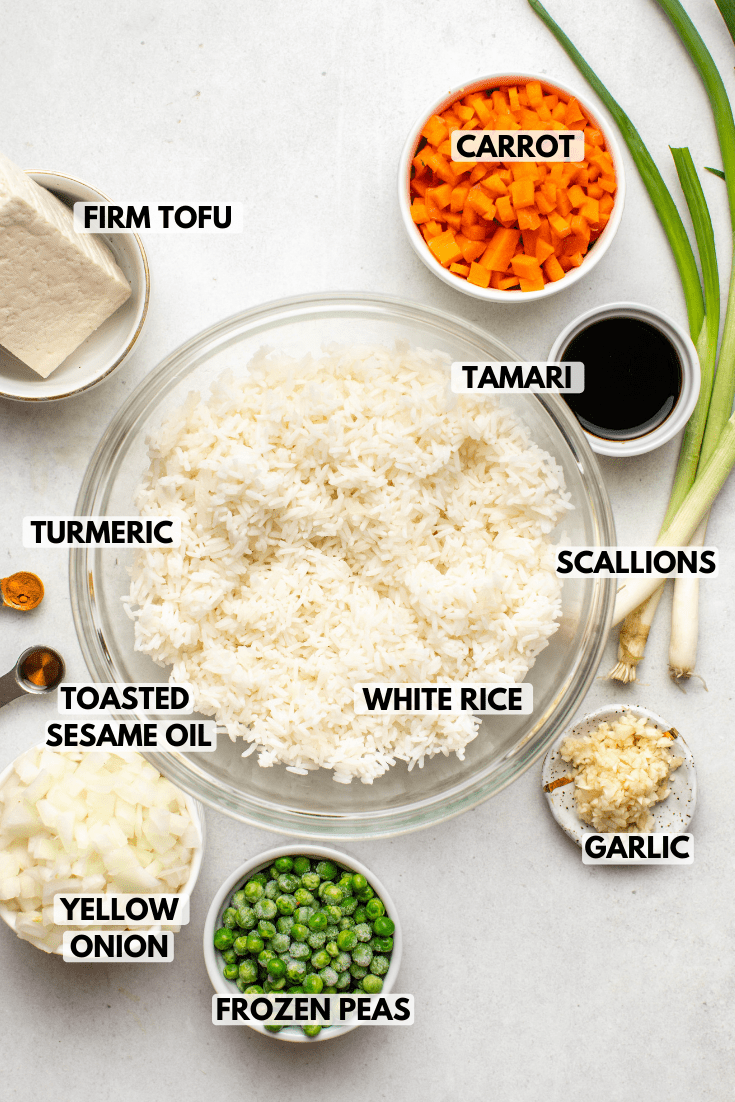
Most takeout-style fried rice is made with stir-fried egg, which is usually cooked separately, thinly sliced, and then added back in at the end of cooking. In this recipe we’ll make a tofu “egg” scramble using crumbled firm tofu, turmeric, and kala namak – a sulfuric “black” salt that tastes very similar to cooked eggs. You can also choose to leave it out, or use a store-bought vegan egg product; see the recipe notes for further instructions.
Other than that, we’ve got all the classic ingredients here – rice, onion, scallions, garlic, peas, carrots, soy sauce or tamari, and toasted sesame oil.
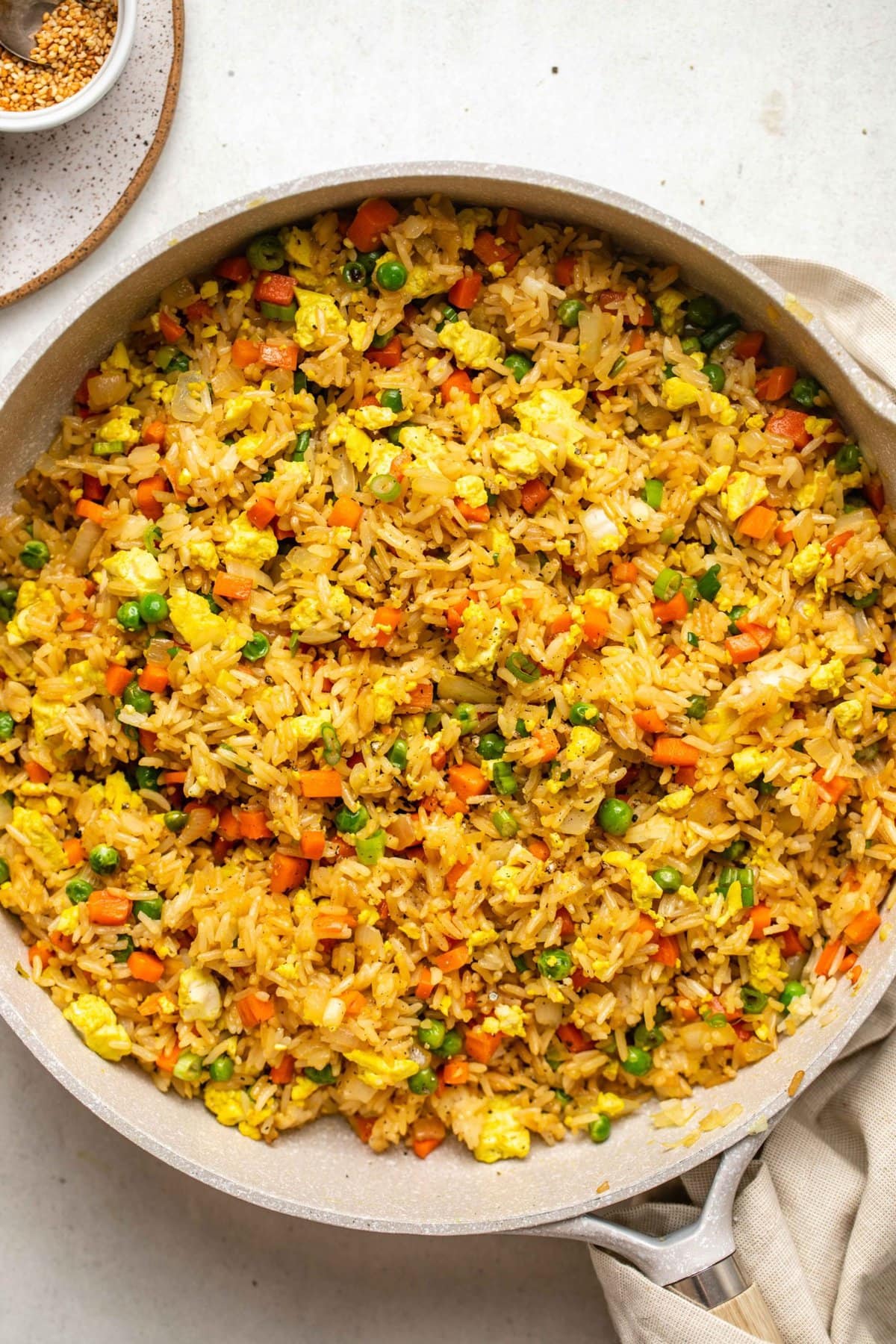
HOW TO MAKE THE BEST FRIED RICE
Making Fried Rice can be broken down into just a few simple steps:
- Optional: Crumble the tofu and sauté it with turmeric to make your vegan “egg”, then set aside
- Sauté the aromatics and vegetables until tender
- Cook the rice over high heat to toast it, then add in the tamari
- Combine with the egg and some toasted sesame oil, then serve as desired.
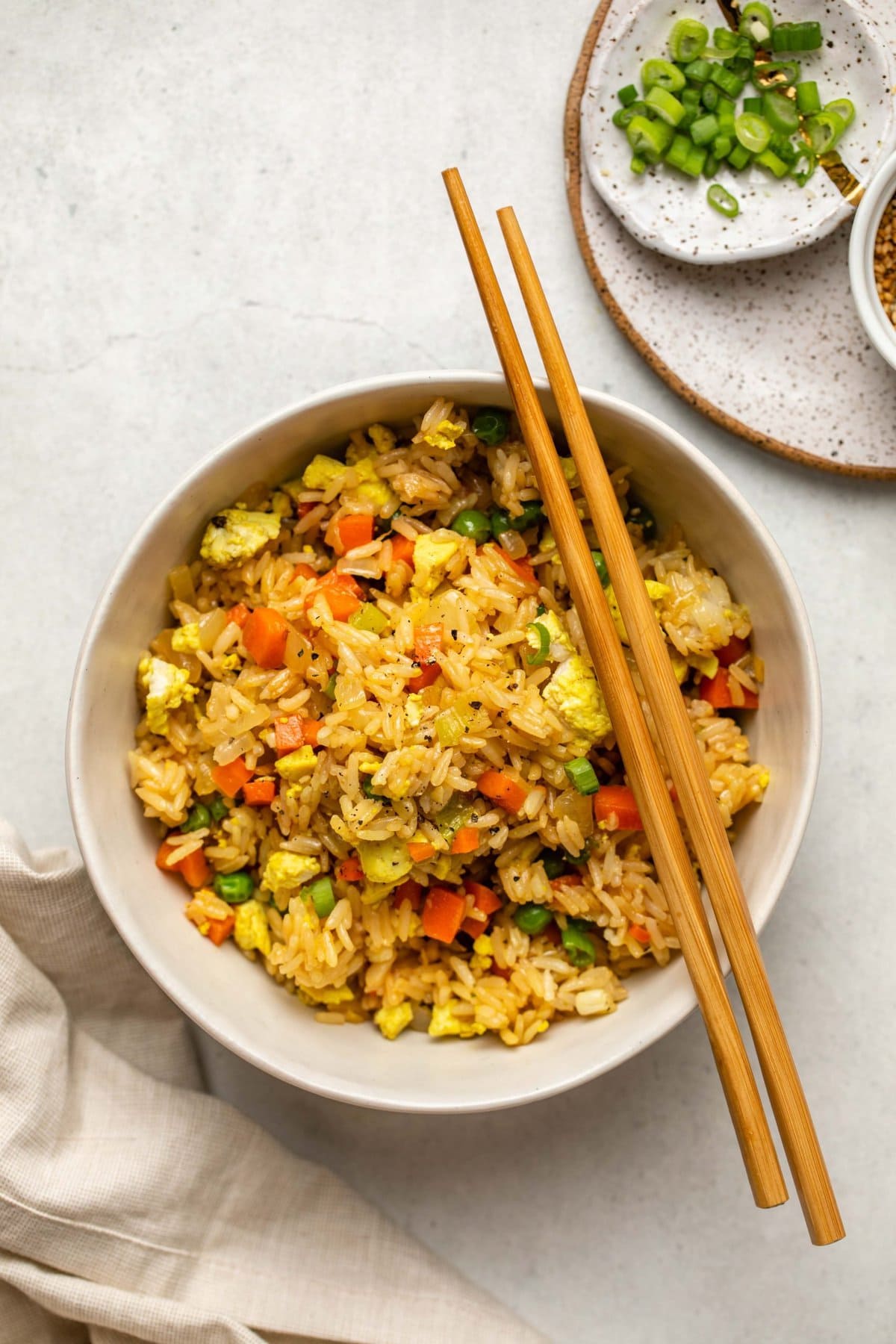
It doesn’t take long to make fried rice, but it does take good technique. The most important quality of good fried rice is to have individual grains of well-seasoned rice, mixed with perfectly cooked vegetables — a.k.a. no mush. Lucky for you, I’ve done (most) of the work and compiled a list of all the best tips and tricks.
- Use Day-Old Rice: dry rice is key here, because it absorbs more flavor and prevents everything from turning into mush. It’s best to use rice that has been made 1-2 days in advance, and chilled overnight in the fridge. If you don’t have leftover rice on hand, you can try flash-freezing your rice by spreading it out thinly on a baking tray and freezing for 15 minutes. It won’t be quite the same, but it’ll work in a pinch. I also personally find that making my rice in an Instant Pot is better than the stovetop; the grains are drier and much more pronounced.
- Break Up Your Rice Before Cooking: use a chopstick or your hands to break up all of the clumps of rice before you add it to the pan. If you add it in and try to use a spatula to separate things, it will also smash the grains together.
- HIGH Heat: Fried Rice loves high heat. Sauté the rice on the highest heat setting on your stove before adding in the Tamari or soy sauce; this will toast the rice first, which brings out more flavor and keeps all of the grains separate.
- Give It Time: let you rice “sit” on the bottom of the pan for 35-45 seconds before stirring it around. This will allow crispy bits of rice to form and will add more flavor to the final dish.
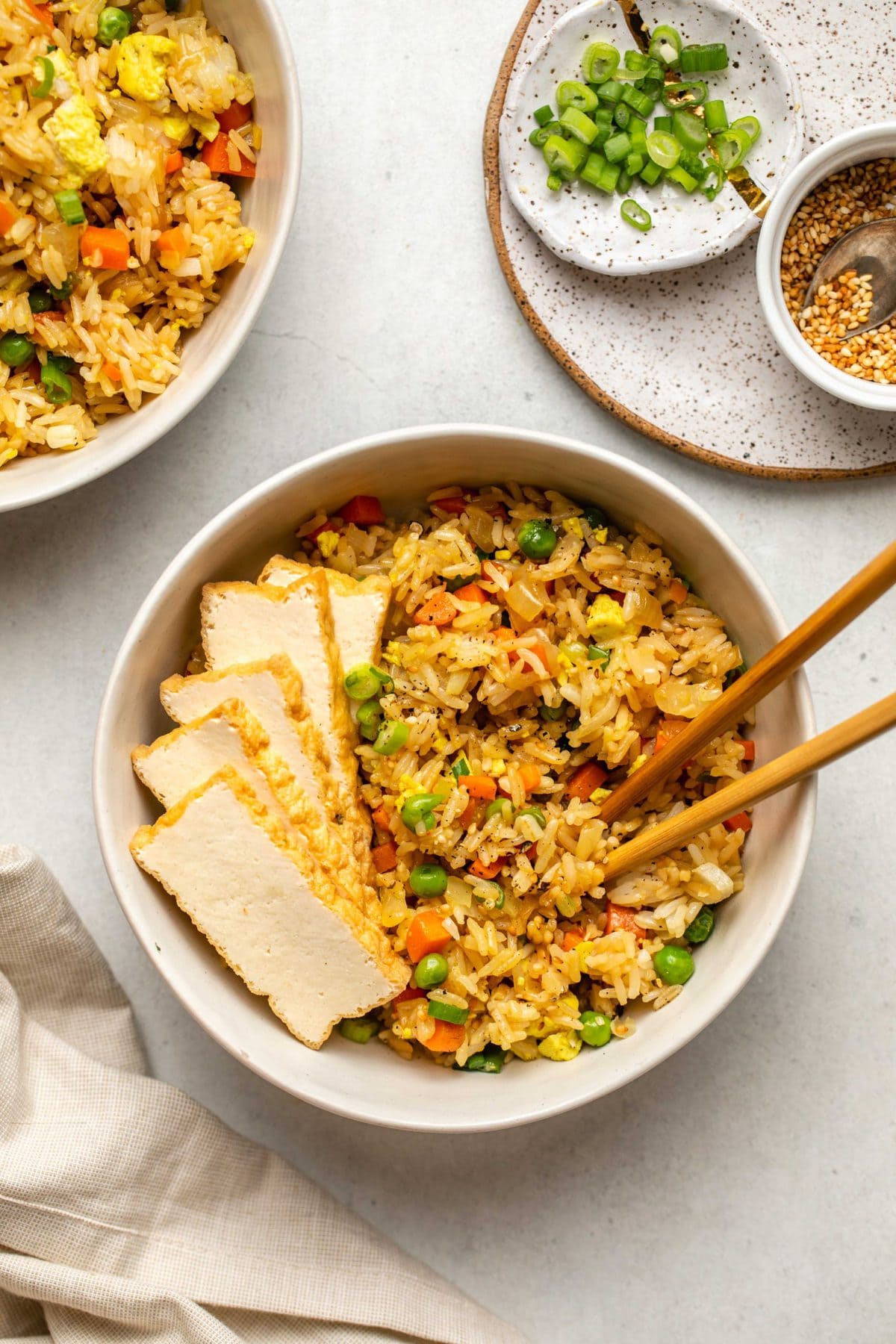
FLAVOR VARIATIONS + ADD-INS:
Rice is essentially a blank vessel waiting to be seasoned – which means there are many many variations on fried rice that are equally delicious. While I went the the “classic” takeout flavors in my recipe, here are a few ways to spice things up and make it your own:
- Vegan Oyster Sauce: Many restaurants will use oyster sauce in their fried rice, which helps give it a darker color and a sweet/salty/slightly fishy flavor. Luckily you can purchase Vegan Oyster Sauce online or at your local asian grocer – add up to 2 teaspoons of oyster sauce along with the tamari for even more flavor!
- Ginger: while not a classic fried rice ingredient, ginger pairs wonderfully with garlic and adds a nice kick
- Kimchi: add up to 1 cup of chopped kimchi to your fried rice along with your veggies! Or, check out this Kimchi Fried Rice recipe I already have on the blog 🙂
- Mushrooms: mushrooms add a nice hearty bite and some great umami flavor, but adding other veggies would be just as great. Broccoli, cabbage, or shelled edamame would also be some excellent choices!
- Spice: if you like things with a little heat, try adding chili oil, crushed red pepper, sriracha, gochujang, or chili garlic sauce to your dish, to taste.
- Pineapple: add 2/3 cup of finely diced pineapple along with your veggies if you’re in for a sweet & salty take!
- Fried or Baked Tofu: this is more of a “topper” than an ingredient addition, but pairing fried rice with seasoned tofu = a match made in heaven.
- Other Faux Meats: most takeout menus include other protein in their fried rice, such as chicken, pork, or shrimp. Try adding a vegan faux-meat alternative to your rice for even more plant-based protein and flavor.
You can serve Fried Rice alone as a main dish, or pair it with a plant-based protein of your choice. This dish is best enjoyed fresh and warm, though leftovers will still keep well in the fridge for up to 3 days.
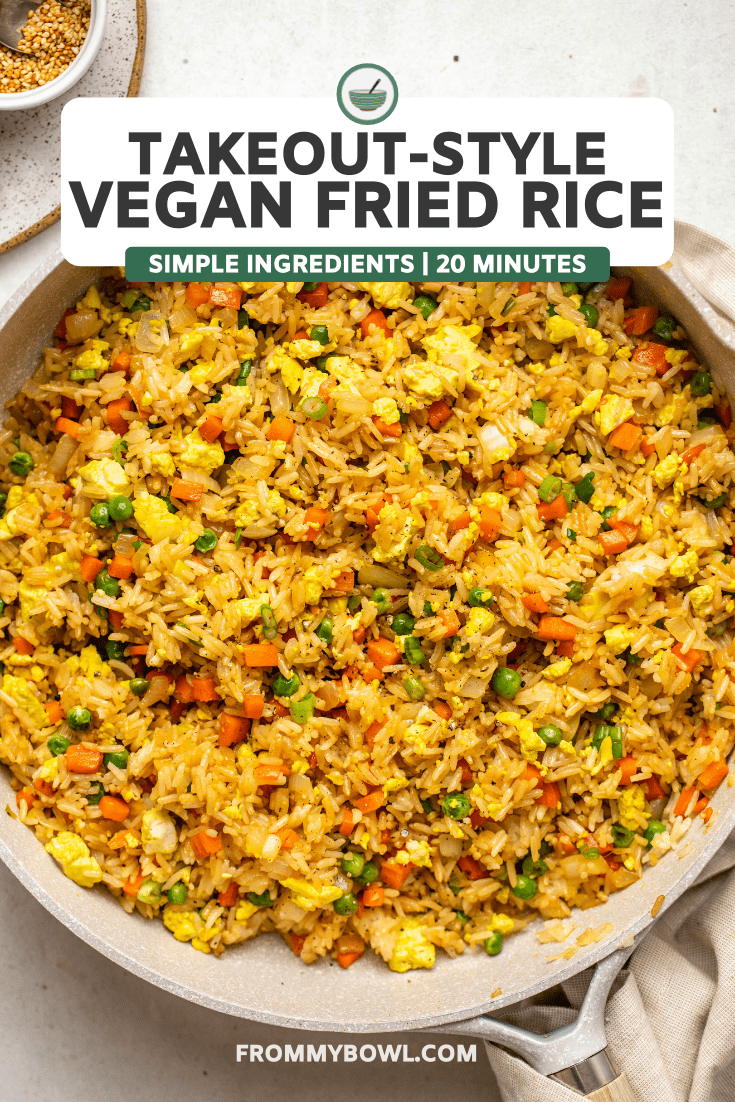
If you’re looking for more Chinese-inspired takeout recipes, you’ll also love this Vegan Beef & Broccoli, this Vegan Sesame Chicken and this Black Pepper Tofu Stir Fry!
Finally, if you make this recipe and decide to share it on Facebook or Instagram, don’t forget to tag me @FromMyBowl + #FromMyBowl! I love seeing your delicious recreations 🙂
PrintVegan Takeout-Style Fried Rice
Learn how to make the best Vegan Takeout-Style Fried Rice at home, in only 20 minutes! This Fried Rice is perfectly seasoned, fluffy, and golden.
- Prep Time: 5 Minutes
- Cook Time: 15 Minutes
- Total Time: 20 minutes
- Yield: Serves 4 to 6 1x
- Category: Main, Side
- Method: Stovetop
- Cuisine: American, Asian
- Diet: Vegan
Ingredients
For the Tofu “Egg”:
- 1 teaspoon peanut oil*
- 7 ounces (200 g) firm tofu, pressed
- ⅛ teaspoon ground turmeric
- Optional: ½ teaspoon Kala Namak (black salt), for an eggy flavor
For the Fried Rice:
- 1 ½ tablespoons peanut oil*
- ½ yellow onion, diced
- 3 scallions, chopped; white and green parts divided
- 3 cloves garlic, minced
- 2 carrots, finely diced (about 1 cup/160 g)
- ⅔ cup (90 g) frozen peas
- Salt and black pepper, to taste
- 4 cups (680 g) cooked rice*
- 3–4 tablespoons low-sodium tamari or lite soy sauce
- ½ teaspoon toasted sesame oil
- Optional: toasted sesame seeds, for garnish
Instructions
- Prep: use a chopstick or your hands to break up the cold rice until no large clumps remain; return to the fridge until you are ready to use it.
- Make the Tofu “Egg”: heat the peanut oil over medium-high heat in a large skillet or wok. Use your hands to crumble the tofu into the pan, then add in the turmeric and stir well. Use a spatula to break up the tofu further, if any piece is too large. Sauté for 3-5 minutes, until the tofu is yellow and the turmeric has completely dissolved. Transfer the tofu into a small bowl and stir in the black salt, if using; Otherwise, season with regular salt to taste. Set aside; quickly clean out the pan and return it to the burner.
- Aromatics + Veggies: warm the remaining peanut oil in the same skillet over medium-high heat. Add the onion, white parts of the scallions, and garlic to the pan; sauté for 3-5 minutes, until the onion is translucent and golden. Then, add in the carrots, peas, and salt and pepper to taste. Sauté for an additional 2-3 minutes, until the peas have thawed.
- Add the Rice: bring the heat to high, then add in the separated rice. Mix everything together with a spatula until the vegetables are evenly incorporated. Then, cook the rice for 5-7 minutes, stirring only occasionally. This enhances the flavor of the rice, and allows some crispy bits to form.
- Final Seasonings: reduce the heat to medium-high; form a well in the center of the skillet, then pour in the tamari. Quickly stir the rice around, to evenly coat everything. Sauté for an additional 1-2 minutes, until the extra liquid has evaporated. Turn the heat off, then stir in the vegan “egg”, toasted sesame oil and green parts of the scallions. Add additional salt and pepper, if desired.
- Serve: let the rice sit in the skillet until the residual heat has warmed the “egg”, then transfer to serving plates and top as desired. Leftovers will keep in the fridge for up to 5 days.
Notes
- Oil: any high-heat oil will work here, though a lot of restaurants will use peanut oil. Hibachi-style restaurants use butter with their fried rice, so you can also swap the oil for equal parts plant-based butter if you’re looking for that flavor profile. If you choose to omit the oil from this recipe, the rice will stick together and turn mushy.
- Rice: Fried rice is normally made with long-grain white rice because it has slightly less starch, but another variety of white rice or brown rice will also work here. Brown rice will slightly change the overall flavor, though.
- Kala Namak (black salt) and toasted sesame oil both lose their flavor with heat, so it’s important to add the tofu “egg” and finishing oil only at the end of cooking after the heat has been turned off.
- Vegan Egg Substitutions: if you do not wish to make the tofu egg you can leave it out, or replace it with JUST Egg – cook the product in a separate skillet like you would the tofu egg, then thinly slice it before adding it to the fried rice at the end of cooking.

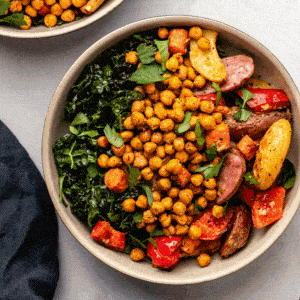
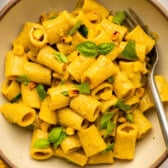



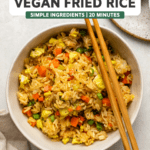
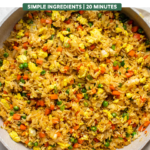
This recipe is AMAZING! I’ll admit, I was skeptical. I have tried in the past to make vegan fried rice and it always falls short. This recipe nailed it! The fried rice literally tasted like takeout! I added a little extra toasted sesame (because I love it) but otherwise followed the recipe to the tee. This dish is going in the regular rotation!
We’re glad you decided to give it a chance. Thank you Annie! ♥
Delicious & incredibly easy to make! I made this tonight for dinner & made a couple adjustments — I used cauliflower rice vs. regular rice & didn’t add tofu, but it was still super flavorful. Thank you for another delicious dinner Caitlin!
Love this recipe! I added in sriracha sauce and curry powder for extra flavor.
Thank you, Allison!🙂
Totally making this – how much dried rice = 4 cups of cooked rice?
It usually a little more than doubles when cooking, so I would say around 1 3/4 -2 cups dry